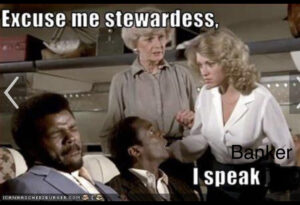Learning to Speak Wolf: The Art of Collections
 Excuse me, is that a wolf at the door?
Excuse me, is that a wolf at the door?
Oh, wait…it’s just a bill collector.
Is that how you feel when you ask for your open invoices to be paid? You really shouldn’t because it is really your client’s responsibility to keep their cash as long as they can. But that doesn’t mean you shouldn’t be paid.
What comprises a good collections management system? Well, the last word is critical: system. You have to have a system and an effective plan to ensure that invoices get paid and on time.
Here are a few ideas that could improve your collections:
- Create and use an accounts receivable (A/R) report.
- Be proactive in your collections.
- Move fast on past-due receivables.
- Consider an early payment discount
- Offer payment plans.
- Diversify your client base.
- Partner with your bank to manage cash.
Whatever you choose to do, be systematic, polite and professional. While talking about money can be a pain, kindness and understanding go a long way. However, being firm and clear is also a big part of the equation of collections.
For more on how to manage and make your collections, call or write to us. TFO Solutions is dedicated to helping entrepreneurs and business owners with their finances from the back office to the boardroom.
*photos courtesy of Unsplash
What Does What You’re Selling Cost You?
 What’s all this talk of selling cold goods? Oh, wait…
What’s all this talk of selling cold goods? Oh, wait…
That’s cost of goods sold. And it is key to your business’ finances if you are making something and selling it. If you don’t know how much your product costs to make, it will be hard for you to understand what makes your business profitable or even make it grow!
Your inventory is key to being able to calculate the cost of goods sold (COGS). It is built around your beginning inventory, adds in purchases made during the period and then subtracts the ending inventory form that total. Or, when expressed an equation:
Simple enough? Well, not so fast– even though the formula is basic it is critical to remember than COGS only applies to those costs directly related to producing goods intended for sale.
COGS tells you your gross profit and is a metric to measure the cost of doing business. It is also a critical measure of profitability and your ability to stay in business. In other words, the life blood of your company’s present and future.
For more on how to determine, manage and control costs, call or write to us. TFO Solutions is dedicated to helping entrepreneurs and business owners with their finances from the back office to the boardroom.
*photos courtesy of Unsplash
“Excuse me, I Speak Banker…”
 One of the most important things you can do as a business owner, is manage your finances and invest in your company and its future. The key to that is having a working relationship with a banker. That relationship means you must learn to speak a new language.
One of the most important things you can do as a business owner, is manage your finances and invest in your company and its future. The key to that is having a working relationship with a banker. That relationship means you must learn to speak a new language.
Bankerease. Ya gotta know their lingo.
It all starts with the first questions they ask you:
- Can you pay?
- Will you pay?
- What if you don’t pay?
Sure, their goal, is to grant you a loan and then service it. But a big part of that is making sure you pay it back.
So, what else in is their vocabulary? Here are a few terms you might hear in your conversations with a banker with whom you are doing business:
- Credit
- Debit
- Debt
- Standing order
- Credit limit
- EBITDA
- Balance sheet
The whole point here is this: like any other business relationship, the key word is relationship. You have to be able to communicate and communicate well. Your banker needs to see you and know you beyond the balance sheet and tax returns. You need to give them confidence that you know what are doing and that you have confidence in your business.
For more on being prepared for that banking conversation, call or write to us. TFO Solutions is dedicated to helping entrepreneurs and business owners with their finances from the back office to the boardroom.
*photos courtesy of Unsplash and Paramount Pictures
Let’s Consider the Humble Invoice
 Ever since the first one was carved into a clay tablet thousands of years ago, collecting for one’s services has involved an itemization of services, terms and prices.
Ever since the first one was carved into a clay tablet thousands of years ago, collecting for one’s services has involved an itemization of services, terms and prices.
The invoice was born. And remains with us, in some form, to this day.
Sure, we’ve all created and issued an invoice at some point in our business lives. Probably still doing them. Or, if you’re smart, have passed on this task to someone who can focus on it full time.
Beyond wanting to collect the cash for your services, what is the value of an invoice?
- It is a record of the transaction between you and your client.
- They are a critical element of accounting and internal controls and audits.
- Their creation allows for approval by the responsible manager.
- They outline the details of terms, unit cost, shipping, handling and anything else you agreed to with your customer.
Now that we know what it is, let’s ask the next question: what’s your process?
Remember invoices go both ways—they aren’t just issued by you, you have to pay the invoices (bills) from your suppliers. And that takes a process. An invoice is usually the heart of your accounts receivable (A/R) and accounts payable (A/P) processes. It starts when you receive (or issue) an invoice and finishes when payment has been made and recorded.
The most important elements of an invoicing system are:
- Data input and verification. This includes everything from product and service information, prices and quantities as well as customer information.
- Billing codes. This will help you track and categorize products and services.
- Payment tracking. How much is due when and from who.
- These are sensitive data that must be kept safe.
Invoices and invoicing are all about cash flow. Get a handle on that, and you will be able to build and manage your business successfully.
For more on invoicing, call or write to us. TFO Solutions is dedicated to helping entrepreneurs and business owners with their finances from the back office to the boardroom.
*photos courtesy of Unsplash
 Excuse me, is that a wolf at the door?
Excuse me, is that a wolf at the door?




 What’s all this talk of selling cold goods? Oh, wait…
What’s all this talk of selling cold goods? Oh, wait…
 One of the most important things you can do as a business owner, is manage your finances and invest in your company and its future. The key to that is having a working relationship with a banker. That relationship means you must learn to speak a new language.
One of the most important things you can do as a business owner, is manage your finances and invest in your company and its future. The key to that is having a working relationship with a banker. That relationship means you must learn to speak a new language.
 Ever since the first one was carved into a clay tablet thousands of years ago, collecting for one’s services has involved an itemization of services, terms and prices.
Ever since the first one was carved into a clay tablet thousands of years ago, collecting for one’s services has involved an itemization of services, terms and prices.